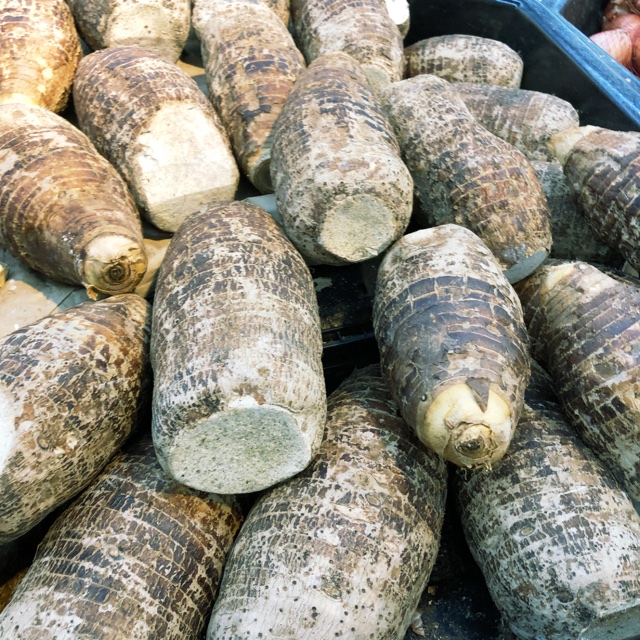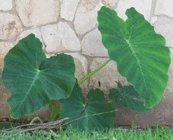

27th March 2022
Nutrition facts of dasheen aka taro root
Taro is a starch-rich, globular fleshy taproot of aroid family plants. Its underground root, known as a corm, is one of the traditional edible root vegetables to a greater parts Asia, Pacific islands, West Africa, and Amazonian regions of South America. Some of the common names are cocoyam, dasheen, Colocasia, elephant’s ear plant, amadumbe, kalo, etc.
Binomially, it belongs to the Araceae (aroid) family, in the large genus, Colocasia.
Scientific name: Colocasia esculenta (L.) schott.
Taro is a large perennial herbaceous plant growing up to 5-6 feet. It's rather large heart-shaped, frilly edged leaves at the end of long, stout petioles appear like elephant’s ear. It grows best in marshy, wet soil and warm, humid climates. The corm grows to a size of a turnip, has globular or oblong shape with brown, tough skin. Its surface is marked by circular rings indicating points of attachment of scaly leaves. Inside, its flesh is white to cream-yellow but may feature different colors depending upon cultivar types. An average-size corm weighs about 2-4 pounds. It’s delicious, crispy-textured meat becomes soft and edible once cooked and has nutty flavor just as in water chestnuts.
 |
| Dasheen (Taro) plant (C.esculenta var.esculenta) Photo courtesy: IngaMun. |
Yautia (Xanthosoma species), also known as tannia, malanga, etc., is similar to taro but smaller and has somewhat elongated, bumpy corms that are grown widely in East Asia, Caribbean and South American regions.
Eddoe (Colocasia esculenta antiquorum) is also a smaller size corm with a irregular surface. It grows widely in India, China, and Japan as well as in some Caribbean countries. It is known as arbiin the Indian subcontinent.
Health benefits of Taro
- Taro or dasheen roots carry more calories than potatoes. 100 grams of root provides 112 calories. Their calorie value chiefly comes from complex carbohydrates, amylose, and amylopectin. However, they are minor source of fats and protein than in cereals and pulses. Their protein levels can be comparable to that of other tropical food sources like yam, cassava, potato, plantain, etc.
- The corms, however, are free from gluten protein. They carry high-quality phytonutrient profile comprising of dietary fiber, and antioxidants in addition to moderate proportions of minerals, and vitamins.
- Taro is one of the finest sources dietary fibers; 100 g flesh provides 4.1 g or 11% of daily requirement of dietary fiber. Together with slow digesting complex carbohydrates, moderate amounts of fiber in the food help gradual rise in blood sugar levels.
- Yellow-fleshed roots and young, tender leaves have significant levels of phenolic flavonoid pigment antioxidants such as ß-carotenes, and cryptoxanthin along with vitamin-A. 100 g fresh taro leaves provide 4825 IU or 161% of RDA of vitamin-A. Altogether, these compounds are required for maintaining healthy mucosa, skin, and vision. Consumption of natural foods rich in flavonoids helps protect from lung and oral cavity cancers.
- It also contains good levels of some of the valuable B-complex group of vitamins such as pyridoxine (vitamin B-6), folates, riboflavin, pantothenic acid, and thiamin.
- Further, the corms provide healthy amounts of some of the essential minerals like zinc, magnesium, copper, iron, and manganese. Besides, the root has good amounts of potassium. Potassium is an essential component of cell and body fluids that help regulate heart rate and blood pressure.

TO RECEIVE NEWS NOTIFICATIONS And Covid NEWS VIA WHATS APP PLEASE SAVE OUR NUMBER AND SEND US A MESSAGE AT 7584896261 AND WE WILL ADD YOU TO OUR LIST







